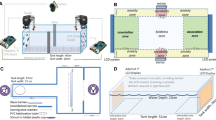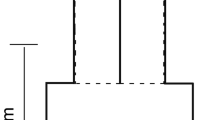Abstract
Chemical communication plays an important role in mediating social interactions of many taxa, particularly arthropods. Many individuals communicate information about their reproductive status to potential mates through distance and/or contact pheromones, an ability that may be advantageous to both signalers and receivers. In this paper, we describe tests of two hypotheses on the role of distance communication in the reproductive behaviors of crayfish (Orconectes quinebaugensis). First, we hypothesized that male crayfish would show stronger attraction towards virgin females (females with no viable sperm) than towards non-virgin females because of the fitness costs (to males) associated with sperm competition. Second, we hypothesized that female crayfish should show differential responses to mature male signals depending on their own sexual history: virgin females should be more strongly attracted to male signals than should non-virgin females because they must mate at least once to be able to fertilize eggs in the spring. Data from two Y-maze experiments yielded support for both hypotheses: males were attracted to signals from virgin females, but not to signals from non-virgins. Likewise, virgin females were attracted to signals from males, but non-virgin females were not. We discuss our data in the context of the potential costs and benefits of mate searching and suggest that distance chemical communication of sexual status may be particularly advantageous when the costs of mate searching are high.



Similar content being viewed by others
References
Acquistapace, P., Aquiloni, L., Hazlett, B. A., and Gherardi, F. 2002. Multimodal communication in crayfish: Sex recognition during mate search by male Austropotamobius pallipes. Can. J. Zool 80:2041–2045.
Aiken, D. E., Waddy, S. L., and Mercer, S. M. 2004. Confirmation of external fertilization in the American lobster, Homarus americanus. J. Crustac. Biol 24:474–480.
Atema, J. 1995. Chemical signals in the marine environment: Dispersal, detection, and temporal signal analysis. Proc. Natl. Acad. Sci. U. S. A. 92:62–66.
Bechler, D. L. 1995. A review and prospectus of sexual and interspecific pheromonal communication in crayfish. Freshwater Crayfish 8:657–667.
Bergman, D. A., Martin, A. L., and Moore, P. A. 2005. Control of information flow through the influence of mechanical and chemical signals during agonistic encounters by the crayfish, Orconectes rusticus. Anim. Behav. 70:485496.
Bergman, D., and Moore, P. 2005. Prolonged exposure to social odours alters subsequent social interactions in crayfish (Orconectes rusticus). Anim. Behav. 70:311–318.
Berrill, M., and Arsenault, M. 1984. The breeding behavior of a northern temperate orconectid crayfish, Orconectes rusticus. Anim. Behav. 32:333–339.
Breithaupt, T. 1999. Urine release in freely moving catheterized lobsters (Homarus americanus) with reference to feeding and social activities. J. Exp. Biol. 202:837–844.
Bushmann, P. J., and Atema, J. 2000. Chemically mediated mate location and evaluation in the lobster, Homarus americanus. J. Chem. Ecol. 26:883–899.
Conner, W. E. 1999. ‘Un chant d’appel amoureux’: Acoustic communication in moths. J. Exp. Biol. 202:1711–1723.
Costanzo, K., and Monteiro, A. 2007. The use of chemical and visual cues in female choice in the butterfly Bicyclus anynana. Proc. R. Soc. Lond. B 274:845–851.
Diaz, E. R., and Thiel, M. 2004. Chemical and visual communication during mate searching in rock shrimp. Biol. Bull. 206:134–143.
Elgar, M. A. 1998. Sperm competition and sexual selection in spiders and other arachnids, pp. 307–339, in T. R. Birkhead, and A. P. Møller (eds.). Sperm Competition and Sexual SelectionAcademic, San Diego, California.
Fenton, M. B. 2003. Eavesdropping on the echolocation and social calls of bats. Mamm. Rev. 33:193–204.
Friberg, U. 2006. Male perception of female mating status: Its effect on copulation duration, sperm defence and female fitness. Anim. Behav 72:1259–1268.
Garvey, J. E., Stein, R. A., and Thomas, H. M. 1994. Assessing how fish predation and interspecific prey competition influence a crayfish assemblage. Ecology 75:532–547.
Gleeson, R. A. 1991. Intrinsic factors mediating pheromone communication in the blue crab, Callinectes sapidus, pp. 17–32, in R. T. Bauer, and J. W. Martin (eds.). Crustacean Sexual BiologyColumbia University Press, New York, New York.
Greenfield, M. D. 2002. Signalers and receivers: Mechanisms and evolution of arthropod communication. Oxford University Press, Oxford.
Hamr, P. 2002. Orconectes, pp. 585–608, in D. M. Holdich (ed.). Biology of Freshwater CrayfishBlackwell Science, Oxford.
Hazlett, B. A. 1990. Source and nature of disturbance—Chemical system in crayfish. J. Chem. Ecol. 16:2263–2275.
Hill, A. M., and Lodge, D. M. 1999. Replacement of resident crayfishes by an exotic crayfish: the roles of competition and predation. Ecol. Appl. 9:678–690.
Houck, L. D., Palmer, C. A., Watts, R. A., Arnold, S. J., Feldhofff, P. W., and Feldhofft, R. C. 2007. A new vertebrate courtship pheromone, PMF, affects female receptivity in a terrestrial salamander. Anim. Behav. 73:315–320.
Jivoff, P. 1997. The relative roles of predation and sperm competition on the duration of the post-copulatory association between the sexes in the blue crab, Callinectes sapidus. Behav. Ecol. Sociobiol. 40:175–185.
Kelly, L. S., Snell, T. W., and Lonsdale, D. J. 1998. Chemical communication during mating of the harpacticoid Tigriopus japonicus. Philos. Trans. R. Soc. Lond. B 353:737–744.
Koga, T., Henmi, Y., and Murai, M. 1993. Sperm competition and the assurance of underground copulation in the sand-bubbler crab Scopimera globosa (Brachyura, Ocypodidae). J. Crustac. Biol. 13:134–137.
Kozlowski, C., Voigt, R., and Moore, P. A. 2003. Changes in odour intermittency influence the success and search behavior during orientation in the crayfish Orconectes rusticus. Mar. Freshw. Behav. Physiol. 36:97–110.
Mathews, L. M. 2003. Tests of the mate-guarding hypothesis for social monogamy: Male snapping shrimp prefer to associate with high-value females. Behav. Ecol. 14:63–67.
Mathews, L. M. and Warren, A. H. 2008. A new crayfish of the genus Orconectes Cope, 1872 from southern New England (Crustacea: Ddecapoda: Cambaridae). P. Biol. Soc. Wash. (in press)
Murai, M., Koga, T., and Yong, H. S. 2002. The assessment of female reproductive state during courtship and scramble competition in the fiddler crab, Uca paradussumieri. Behav. Ecol. Sociobiol. 52:137–142.
Oh, S. J., and Hankin, D. G. 2004. The sperm plug is a reliable indicator of mating success in female Dungeness crabs, Cancer magister. J. Crustac. Biol. 24:314–326.
Papke, R. S., Kemp, D. J., and Rutowski, R. L. 2007. Multimodal signalling: Structural ultraviolet reflectance predicts male mating success better than pheromones in the butterfly Colias eurytheme L. (Pieridae). Anim. Behav. 73:47–54.
Schiestl, F. P., and Ayasse, M. 2000. Post-mating odor in females of the solitary bee, Andrena nigroaenea (Apoidea, Andrenidae), inhibits male mating behavior. Behav. Ecol. Sociobiol. 48:303–307.
Simmons, L. W., and Siva-Jothy, M. T. 1998. Sperm competition in insects: Mechanisms and the potential for selection, pp. 341–434, in T. R. Birkhead, and A. P. Møller (eds.). Sperm Competition and Sexual SelectionAcademic, San Diego.
Stebbing, P. D., Bentley, M. G., and Watson, G. J. 2003. Mating behavior and evidence for a female released courtship pheromone in the signal crayfish Pacifastacus leniusculus. J. Chem. Ecol. 29:465–475.
Tierney, A. J., and Dunham, D. W. 1982. Chemical communication in the reproductive isolation of the crayfishes Orconectes propinquus and Orconectes virilis (Decapoda, Cambaridae). J. Crustac. Biol. 2:544–548.
Uhía, E., Cordero, and Rivera, A. 2005. Male damselflies detect female mating status: Importance for postcopulatory sexual selection. Anim. Behav. 69:797–804.
Urbani, N., Sainte-Marie, B., Sevigny, J. M., Zadworny, D., and Kuhnlein, U. 1998. Sperm competition and paternity assurance during the first breeding period of female snow crab (Chionoecetes opilio) (Brachyura: Majidae). Can. J. Fish. Aquat. Sci. 55:1104–1113.
Widemo, F., and Johansson, B. G. 2006. Male-male pheromone signaling in a lekking Drosophila. Proc. R. Soc. Lond. B 273:713–717.
Wyatt, T. D. 2003. Pheromones and animal behaviour: Communication by smell and taste. Cambridge University Press, Cambridge.
Zulandt, Schneider, R. A., Schneider, R. W. A., and Moore, P. A. 1999. Recognition of dominance status by chemoreception in the red swamp crayfish, Procambarus clarkia. J. Chem. Ecol. 25:781–794.
Acknowledgments
We are grateful to L. Adams, M. Basile, M. Buckholt, and J. Caron for assistance in the field and laboratory, and D. Gibson for laboratory support. We also thank H. Johari and W. Durgin (Sr.) for assistance in the design and construction of our apparatus. We also thank two anonymous reviewers for helpful comments on the manuscript. Finally, we wish to thank the United States Army Corps of Engineers for granting a Special Use Permit (to LM) to collect crayfish at the East Brimfield Dam in Sturbridge, MA.
Author information
Authors and Affiliations
Corresponding author
Rights and permissions
About this article
Cite this article
Durgin, W.S., Martin, K.E., Watkins, H.R. et al. Distance Communication of Sexual Status in the Crayfish Orconectes quinebaugensis: Female Sexual History Mediates Male and Female Behavior. J Chem Ecol 34, 702–707 (2008). https://doi.org/10.1007/s10886-008-9491-6
Received:
Revised:
Accepted:
Published:
Issue Date:
DOI: https://doi.org/10.1007/s10886-008-9491-6




